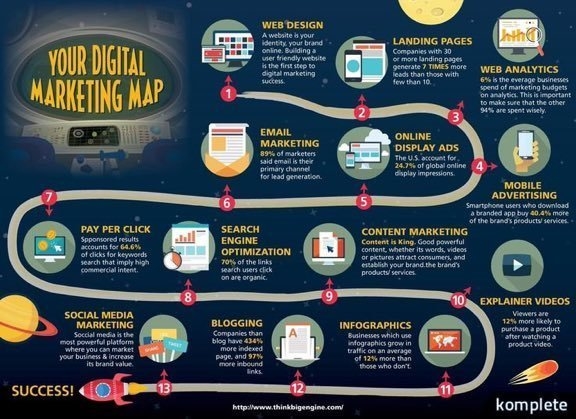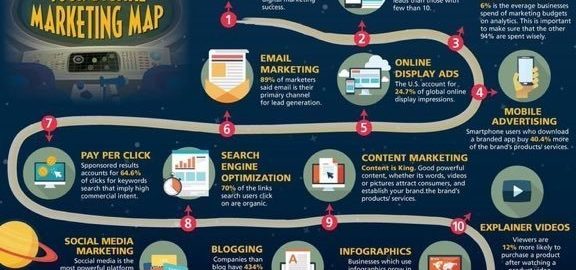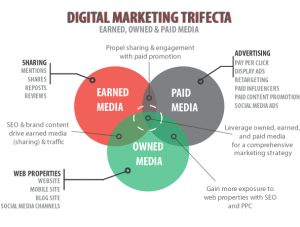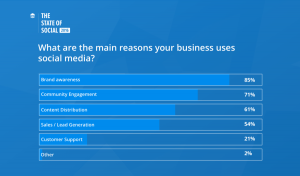Digital media and marketing, even narrowing our focus to digital marketing, aren’t synonymous. Just as marketing is more than advertising, digital marketing is more than digital media. To be effective, digital advertising must incorporate the core concepts of marketing (all of the marketing, not just advertising), then adapt them to a digital world.
What is digital media?
Contemporary views of media in a marketing context refer to channels for messaging about your brand, commonly advertising. In a traditional world, advertising used print, broadcast, and outdoor media, along with direct marketing and promotions that included everything from discounts to materials like hats to the sponsorship of events like the US Open.
Hence, the meaning of digital advertising refers to such advertising methods that involve digital channels, including social media, online advertising, and websites. According to Maryville University, digital media is:
Defining digital media is difficult because it is rapidly evolving alongside innovations in technology and how people interact with it. As we move into the future, our day-to-day use of digital media will likely only increase, particularly as holographic and artificial intelligence (AI) technologies are developed and incorporated into our daily lives.
How digital media fits with marketing
As I mentioned, digital media isn’t the same as marketing, which creates confusion for many businesses exploring ways to optimize their digital marketing strategies. And, just as happened with traditional advertising, some firms miss the link between advertising and marketing to their detriment. Just as you don’t want photographers crafting your strategy, you shouldn’t want web and graphic designers or developers to draft your online presence because core marketing concepts should guide strategy, integrating tactics across a broad range of digital options.
Core marketing concepts
Obviously, your online success focuses on generating sales, building brand loyalty, and expanding the reach of your message to as many folks fitting target personas as possible. Just creating pretty pictures and a useful UX doesn’t ring the cash register. That’s where marketing comes in.
Marketing strategy classically consists of 4 elements–called the 4 Ps, product, price, promotion, and place (distribution). Hence, even from the outset, marketing’s focus involves much more than promotion and advertising. Among the key elements needed for successful marketing beyond promotion are:
- Superior customer service
- Lead generation and effective nurturing
- Integration across tactics that fits the brand, its target personas, and opportunities
- Competitive pricing and financing
- Innovative products that stand out from those offered by the competition
- Distribution channels that ensure products are available at the right place in the right time
- Buy-in across other functional areas focused on the singular goal of meeting or exceeding customer expectation
The range of digital marketing tactics
To better understand the range of digital marketing tactics, take a look at the infographic below.

Image courtesy of Think Big Engine
Notice the broad range of tactics needed for online marketing success, including those involving
- technical skills, such as search engine optimization (SEO) and analytics
- graphic skills inherent in advertising copy and infographics
- writing skills needed for social media marketing and blogging
- video skills
Further complicating the matter of digital marketing is the need for speed. Gone are the days when graphic designers worked for weeks making tedious adjustments to an image or an ad went through rounds of approvals and testing lasting days or weeks. Digital marketing happens without much warning when an external stressor, like a negative tweet or a visual emerges showing your product in a negative light. Plus, rather than producing an ad every couple of months, you now need content on a daily basis, often multiple times per day across a variety of platforms with different requirements.
Adapting marketing to a digital world
Just as digital media and marketing aren’t the same, firms can’t expect strategies developed in a traditional world to translate effectively in a digital one. To learn more about how traditional and digital media differ, check out this post.
As a start in providing concrete advice for businesses that must adapt to marketing in a digital world, let’s look at the factors contributing to success one at a time.
1. Providing superior customer service
The need for providing superior customer service as a success strategy can’t be overstated. Poor customer service results in the ultimate failure of your business as no firm can survive long-term once customers discover their failures. And, in today’s digital world, negative word-of-mouth spreads quickly until most of your prospective market knows to avoid your brand.
Not only do sites like Amazon offer customer ratings and feedback, but online review sites, such as Yelp, amplify discontent so that a few bad experiences can overwhelm your brand images resulting in declining sales.
Providing superior customer service in a digital world involves:
- Active listening
- Open, bi-directional communication
- Quick response to solve problems
- Public acknowledgment of your failures rather than burying them
- Online customer service available 24/7
- Celebrating customers who support your brand
2. Lead generation and nurturing
Lead generation and nurturing were once the domain of business-to-business marketers since companies only became aware of consumers once they purchased products. In a digital world, personalizing the customer journey for individual consumers is not only possible but necessary to optimize brand performance.
Balancing privacy with personalization, brands must develop relationships with customers long before their first purchase and drive not only that first purchase but sustain the long-term purchase behavior to keep customers coming back for your products.
Among the factors allowing for effective lead generation and nurturing are:
- SEO and content marketing
- Email marketing
- Retargeting
- Exit-intent popups
- Marketing automation
All these tactics rely on knowing how consumers move from awareness to purchase to brand loyalty and brand advocacy. And, you need effective monitoring and analytics to quantify your marketing performance with the hopes of improving the effectiveness of both your efforts to reach new customers (lead generation) and drive them down the conversion funnel (lead nurturing). Without this information, you have little hope of utilizing content and other lead strategies to improve performance.
3. Integration across tactics
Effective integration of marketing tactics encompasses a wide range of skills. In the traditional world, these skills were distributed across your team, with highly trained individuals possessing strong skills in a single area. Today, with the speed necessary to implement a sound digital marketing strategy, distributed skills simply aren’t possible as the handoff between departments is never smooth, with each handoff adding time to the output, especially as departments face different priorities and backlogs.
Instead, you need players with multiple skills, sacrificing the proficiency that comes with having a single skill, such as copywriting, with a breadth of skills performed at a less proficient level. Hence, combining copywriting, with digital design, with technical skills such as web or social, along with some marketing skills produces a more integrated strategy that responds more quickly to content needs, thus producing a better outcome.
4. Competitive pricing
In a digital world, shoppers get nearly instantaneous access to pricing across a broad range of products and international companies in low-cost regions, notably China, offer must cheaper products than those available domestically if customers are willing to wait for delivery from across the globe.
It’s a myth that customers always choose the cheapest product. Instead, consumers weigh their options by considering price and value, which represents the benefits offered at a given price point. Thus, optimal performance creates a willingness to pay a higher price. Examples of factors increasing value are:
- product superiority in critical areas
- availability
- ease of use
- fit with existing products, ie. batteries in a tool or blades in a razor
- appealing design
Thus, as with marketing in any world, messaging must go beyond price to emphasize the value received through purchasing your brand over that available from competitors.
5. Innovative products
Creating innovative products and maintaining that advantage over time contributes to the success of your marketing efforts and increases the value of your products to allow premium pricing. Think about the pricing structure for Apple products like the iPhone and iPad, which exceed those available from competitors. Apple achieved this premium price by consistently providing products that lead the industry, with the first tablet computer and first smartphone. By anticipating consumer needs and implementing strategies to bring state-of-the-art technology into the product design, Apple became one of the most successful brands in the world.
We talk about first-mover advantage because staying ahead of competitors in any industry contributes to market performance. Although, as pointed out in this article from HBR, first-mover advantage doesn’t ensure success, it does contribute to that success.
6. Effective distribution channels
For the most part, consumers want to buy things where it’s convenient and they want things right away. Deferred gratification doesn’t fit with most Western Cultures, hence a rise in the appeal of online purchases that consumers pick up in the store, especially during the pandemic. This combination provides consumers the advantage offered by online buying, including shopping in your pajamas at 4 in the morning, with the immediacy of getting your products today. Plus, you never have to get out of the car and don’t waste time trying to find your desired item in a crowded warehouse full of options.
For online businesses without a physical presence, creating effective distributions channels present challenges, since our logistics system (of trucks, planes, boats, etc) isn’t set up to efficiently handle ones and twos, but entire truckloads (containerloads) of product. Hence, even businesses without retail stores need local distribution centers that reduce the length products travel between the storage facility and the customer, which reduces the cost and time needed to deliver products to buyers. In the early days of Amazon, the business focused on buying and stocking warehouses distributed strategically around the country (and later the world). The company didn’t make any money for years as they built this distribution system and, in fact, lost so much money for so long pundits predicted their ultimate failure. By taking a long-term view of the business, Amazon positioned itself to become the massive online retailer it is today.
7. Buy-in from across the company
Companies consist of departments such as finance and accounting, operations management, HR, and many others. Each department has goals that must fit the overarching goal of market success. Without consistent attention to the goal of efficiently marketing goods to consumers, the business gets pulled in many directions, resulting in sub-optimal solutions. Like the human body, firms must recognize that the survival of the person trumps the importance of the heart or lungs. Instead, these two systems must work together with the other systems that keep the person alive.
A great example of what happens when firms take their eyes off the ball (which is customer satisfaction) comes from the failure of a business that competed in Best Buy’s space (we don’t want to mention the brand, but you can Google it). Financial managers within the company recognized the write-offs necessary when customers returned products in a market where obsolescence is measured in weeks not years. Further, open packages from these returns were less desirable and often resulted in a discounted sale. To combat the decreased profits necessitated by returns, the company instituted draconian return policies that reduced the number of allowable returns. Instead of boosting profitability, profits declined precipitously as consumers weighed the risk of losing their money when a product didn’t meet their needs with the available options from other stores without such return policies. Soon, so much of the market shifted to competitors that the consumer electronics firm shuttered its doors.
Thus, a company must work together to achieve market success with each department working toward the same goal. HR supports the marketing goal by bringing in skilled workers, training them in succeeding in their corporate culture, and motivating all employees toward their best performance. Operations management must produce valuable products to meet forecast volumes with 0 defects, while R&D works toward replacing existing products with more innovative ones to meet future needs.
Recent trends toward flatter management structures and cross-functional teams are good beginnings in the race toward gaining buy-in from the entire organization toward the singular goal of optimizing market performance.
Conclusion
Marketing and media (whether traditional or digital) must fit together to reinforce the overarching goal of optimizing market performance recognizing that the digital world requires modification of both marketing and messaging efforts in support of market performance.
I hope you found this article valuable. Please add your comments below to keep the conversation going.
Digital & Social Articles on Business 2 Community
(65)








